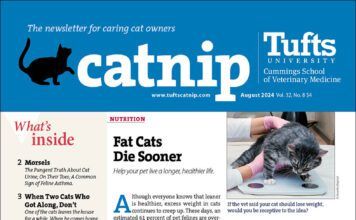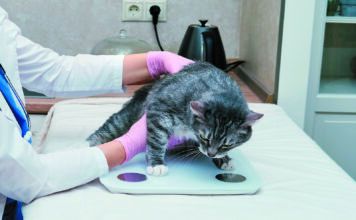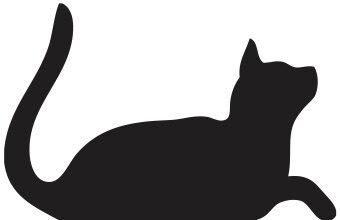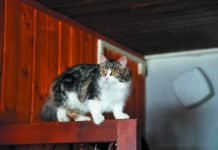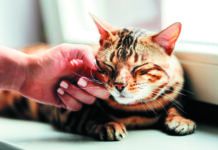On Their Toes
People walk plantigrade, meaning that when we take a step the entire sole of the foot reaches the ground, from the toes to the heel. Not so, cats. Their locomotion is digitigrade, which is to say that their heels do not touch the ground. That provides them with both agility and speed, say, when they want to escape a predator or catch their next meal. It’s a more stealth way of ambulating as it’s a relatively quiet movement.
When Two Cats Who Got Along, Don’t
You’re a two-cat or multi-cat household, and all of your felines do fine together. They don’t mind looking out the same window at the same time and even do some hanging out and playing together. Then one of them goes to the vet. Or both go, or they all spend a couple of days at a boarding facility. When the one cat or the group of cats arrives back home, you might assume there’d be relief at the routine going back to normal, but instead, things turn aggressive between the pets. There’s swatting, maybe biting and scratching. It’s as if the cats never knew each other—even if they were taken for their appointment in the same carrier!
The Truth(s) About Cats and Water
It’s untrue that cats are universal water haters. Sure, no cat wants to be unceremoniously dumped in the sink and have water and suds poured all over him willy nilly, but felines’ reputation for being aquaphobic is belied by the facts. Consider that many people think cats can’t swim. But cats in general can swim just fine, and some breeds actually enjoy it. Among them: the Turkish Angora and the Turkish Van.
If Your Cat Requires Water by Needle
Liver disease, pancreatitis, diabetes, chronic kidney failure. These are among the main illnesses that can keep a cat from drinking enough water by mouth. Sometimes it’s because the condition causes excess urination, and sometimes it’s because the disease zaps the cat of the energy required to drink the fluid her body needs. It’s a more common problem than you might assume. Chronic kidney disease by itself affects more than half of all cats over the age of 10 and close to 70 percent of cats over age 15, according to at least one estimate.
Why Cats Get Stuck in Trees—And How to Get Yours Down
If you think about the fact that cats tend to jump down from high places rather than climb down, it becomes easier to understand why a cat who has climbed high up a tree may have difficulty descending. They climb in the first place either to chase an animal, escape from one, or simply because they like to climb and be high up. But once they get high enough, they know that jumping carries risk. Cats do survive jumps from extremely high perches but, contrary to popular opinion, not always—and not always without injury.
The Zoomies: Anything to Be Concerned About?
Behavioral scientists call them Frenetic Random Activity Periods, but you probably know them as the zoomies. We’ve all seen them. A cat goes from lounging languidly to tearing back and forth with no warning. It’s more common in kittens and other young cats, but many cats never grow out of the behavior completely. What drives it?
No Pets Allowed?
Q: There’s a building with an apartment available that I’d like to move into, and I’ve seen cats in some of the windows. But when I went to sign the lease it had a “no pets allowed” clause, and the fine print didn’t list any exceptions. I have held off but am figuring that since I’ve already seen cats there, bringing my own will just be a form of jaywalking and I won’t have any problems. What do you think?
Download The Full July 2024 Issue PDF
- Don’t Pursue Your Cat…
- Morsels: Things That Don’t Go Together: Your Cat and Narrow Spaces; Recognizing a Partial Seizure; In Your Cat’s Old Age; You May Need to Give More Frequent Manis and Pedis.
- What’s the Right Number of Meals to Feed Your Cat Each Day?
- Is it Dangerous to Let Your Cat Sleep in Your Bed?
- July 4th: Your Cat’s Least Favorite Holiday
- Should Your Cat Be an Indoor Pet or Indoor/Outdoor?
- Are NSAIDs the Right Choice for Long-Term Use in Cats?
- Dear Doctor
Don’t Pursue Your Cat…
If you’re in the mood to pay your cat some nice attention with stroking and cooing, it might not be the right time. You have to wait till he’s in the mood. Never try to chase or otherwise pursue your pet in a bid for togetherness. It will backfire.
Things That Don’t Go Together: Your Cat and Narrow Spaces
It can be hard to find room in the house for all your cat’s stuff: scratching post, food and water bowls, toys, bed, litter boxes. Many people relegate many or all of those resources to a back hallway, a staircase landing, or a mudroom off the kitchen. It’s understandable. It keeps the items close by yet more or less out of sight. But from your cat’s point of view, narrow areas like that make unnerving choices.
Recognizing a Partial Seizure
Drooling, eyelid or facial twitching, excessive vocalizations, growling, and weird head, neck, or limb movements. Each of these can be a sign of a partial seizure, which is much more common in cats than generalized seizures. Partial seizures are also harder to recognize for what they are, unlike a generalized’s seizure’s sometimes violent shaking and loss of awareness.
What’s the Right Number of Meals to Feed Your Cat Each Day?
Many people feed their cat twice a day—once in the morning and once in the evening—and cats in general seem to do fine on that schedule. Some people feed their cats just once a day, and even those pets appear to do okay, although they might like their food divided between two feedings in order not to get too hungry overnight. But if a cat had his druthers, he’d probably prefer several small meals a day—three, four, or even five. Why?

